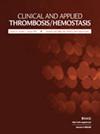Biomarkers Profile in Provoked Versus Unprovoked Deep Venous Thrombosis
IF 2
4区 医学
Q2 HEMATOLOGY
引用次数: 0
Abstract
Venous thromboembolism (VTE), including deep venous thrombosis (DVT) and pulmonary embolism (PE), represents a substantial healthcare challenge. Provoked and unprovoked DVT cases carry distinct risks and treatment considerations. Recognizing the limitations of this classification, molecular markers may enhance diagnostic precision and guide anticoagulation therapy duration relying on patient history and risk factors. This preliminary, open-label, prospective cohort study was conducted including 15 patients (10 provoked DVT and 5 unprovoked DVT) and a control group of healthy plasmatic subjects. Plasma levels of 9 biomarkers were measured at diagnosis (baseline, day 0, and D0) and after 30 days (day 30-D30). Patient demographics, clinical data, and biomarker concentrations were analyzed. Serum concentrations of D-dimer, von Willebrand factor, C-reactive protein, and Anti-Xa were elevated in DVT groups at D0 compared to controls. No significant differences were observed between the provoked and unprovoked groups on the day of diagnosis and 30 days later. Over 30 days, the provoked group exhibited significant biomarker changes related to temporal assessment. No significant differences were noted in the biomarker profile between provoked and unprovoked DVT groups. This study is indicative of the concept of individualized thrombosis assessment and subsequent treatment for VTE. Larger cohorts are warranted to validate these findings and further define the most appropriate use of the molecular markers.诱发与非诱发深静脉血栓的生物标记物概况
静脉血栓栓塞症(VTE),包括深静脉血栓形成(DVT)和肺栓塞(PE),是医疗保健领域的一大挑战。诱发和非诱发 DVT 病例具有不同的风险和治疗注意事项。认识到这种分类的局限性,分子标记物可以提高诊断的精确性,并根据患者的病史和风险因素指导抗凝治疗的持续时间。这项初步、开放标签、前瞻性队列研究包括 15 名患者(10 名诱发深静脉血栓和 5 名无诱发深静脉血栓)和健康血浆受试者对照组。在诊断时(基线、第 0 天和第 0 天)和 30 天后(第 30-D30 天)测量了 9 种生物标志物的血浆水平。对患者的人口统计学特征、临床数据和生物标志物浓度进行了分析。与对照组相比,深静脉血栓组在D0时血清中的D-二聚体、von Willebrand因子、C反应蛋白和抗Xa浓度升高。在诊断当天和 30 天后,诱发组和未诱发组之间未发现明显差异。在 30 天内,诱发组表现出与时间评估相关的显著生物标志物变化。诱发组和非诱发组的生物标志物特征无明显差异。这项研究表明了对 VTE 进行个体化血栓评估和后续治疗的概念。为了验证这些发现并进一步确定分子标记物的最合适用途,有必要进行更大规模的队列研究。
本文章由计算机程序翻译,如有差异,请以英文原文为准。
求助全文
约1分钟内获得全文
求助全文
来源期刊
CiteScore
4.40
自引率
3.40%
发文量
150
审稿时长
2 months
期刊介绍:
CATH is a peer-reviewed bi-monthly journal that addresses the practical clinical and laboratory issues involved in managing bleeding and clotting disorders, especially those related to thrombosis, hemostasis, and vascular disorders. CATH covers clinical trials, studies on etiology, pathophysiology, diagnosis and treatment of thrombohemorrhagic disorders.

 求助内容:
求助内容: 应助结果提醒方式:
应助结果提醒方式:


